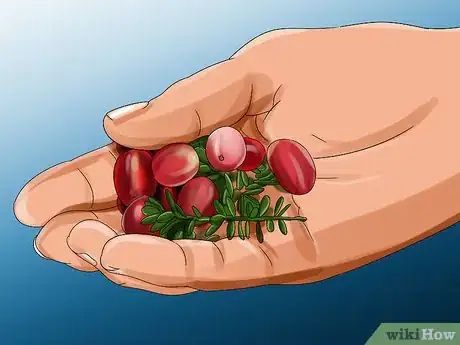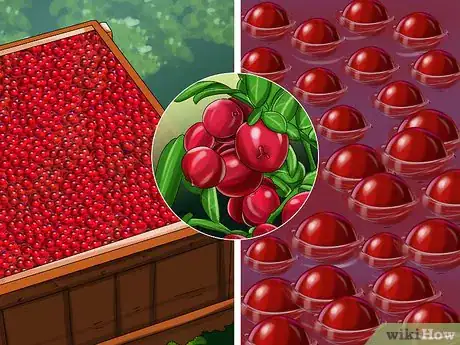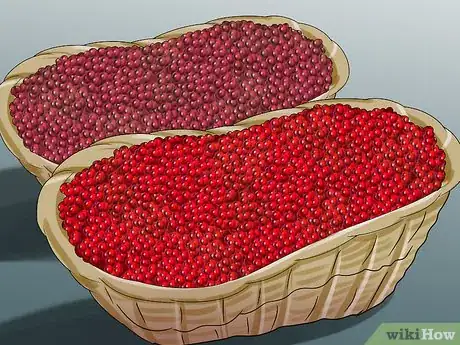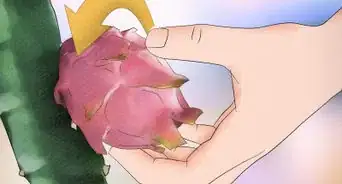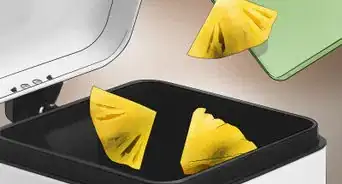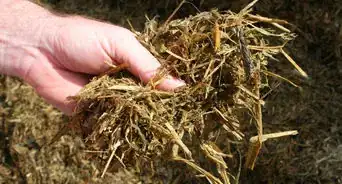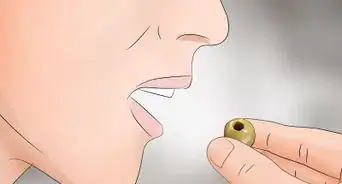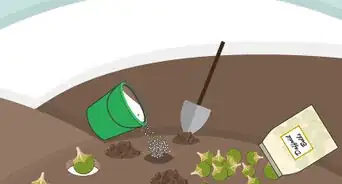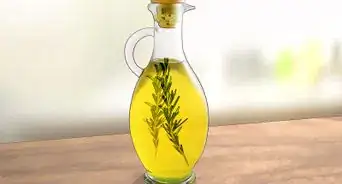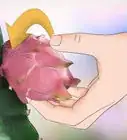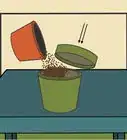This article was co-authored by Andrew Carberry, MPH. Andrew Carberry is a Food Systems Expert and the Senior Program Associate at the Wallace Centere at Winrock International in Little Rock, Arkansas. He has worked in food systems since 2008 and has experience working on farm-to-school projects, food safety programs, and working with local and state coalitions in Arkansas. He is a graduate of the College of William and Mary and holds a Masters degree in public health and nutrition from the University of Tennessee.
This article has been viewed 71,863 times.
Cranberries should probably be called the ruby of North America. These wonderful little berries have been delighting North American taste buds for thousands of years. A relative to the blueberry, cranberries grow like some blueberries do--on low-lying vines. They can be harvested the same way--by hand or raked off the vines. Farmers, however, use much more economical methods of harvesting cranberries. So, when fall comes around, get ready to create cranberry swimming pools with the wet method of harvesting cranberries, or get some walking in as you collect your cranberry crop with the dry method of harvesting. Harvesting cranberries by hand is ideal if you only have a small amount of berries to harvest.
Steps
Harvesting Cranberries Using the Dry Method
-
1Know the right time of year to pick cranberries. Cranberries ripen in the fall. You can tell when they begin to ripen because they will change from green to bright red in color. This happens at the beginning of September and generally ends in mid-November. Cranberries that are dry harvested are less likely to get damaged than wet harvested berries. Dry harvested berries are the ones sold fresh at markets and stores.
- Be sure to harvest by the first frost of the year for good quality berries.
-
2Choose a dry day. Dry harvesting of cranberries cannot be executed if there is any moisture on the plant. This includes rain, dampness from a frost or even dew. If there is any sign of wetness on the plants, hold off harvesting until things dry out.[1]Advertisement
-
3Walk a mechanical picker through the fields. Similar in workings to a large, push lawn mower, the picker mows over the field. It has moving comb-like fingers that separate the berries from their vine. The berries are then shifted into an attached container, like a grass catcher. The berries in the container are then collected and sent to be processed. The one downside to the mechanical picker is that the machine can occasionally damage berries. Damaged berries are best used for juices and sauces.
- If you are not growing many cranberry bushes, you could consider picking your cranberries by hand. While this takes a good deal of time, it is a more affordable way to pick the berries. Picking by hand is not recommended if you have a cranberry bog. Invest in a mechanical picker, which you can order online or through your local yard supply store. You can also rent or borrow a mechanical picker before you buy to decide if you want to make the investment.
- You can also use a handheld scoop if you only have a few bushes. This is much more cost effective for a few bushes than a mechanical picker.[2]
Harvesting Cranberries Using the Wet Method
-
1Know that cranberries grow in bogs. The reason that there are two ways to pick cranberries (dry or wet) is because cranberries grow in bogs. What a lot of people don’t know is that bogs are not always wet, thus farmers are able to dry harvest the berries. The other harvesting option is to flood the bogs with water. Cranberries float, so when the bogs are flooded, detached berries from the stems and float to the top of the water, where they are able to be scooped up.[3]
-
2Flood the bogs. The harvest begins a day before the farmer actually collects the berries as he pumps water into the cranberry fields. The amount of water can range from six up to about 18 inches (45.7 cm). These bogs are impermeable--specifically created with layers of various growing mediums--so flooding them is not difficult.
- However, keep in mind that flooding harvest requires that you prepare the ground before you flood it. It is also only worth doing if you have many bushes. If you only have a few, then picking by hand is your best bet.
-
3Stir the waters. Machines, fondly called 'egg beaters' are used to agitate the waters. This process separates the cranberries from their vines. Because cranberries grow with a little pocket of air inside them, they float. All loosened berries come to the surface of the water.[4]
-
4Collect the berries. A net is stretched from one end of the bog to the other. It is walked across the field and gathers the berries as it moves. Instead of a net, sometimes a machine like the boom of a boat is used to gather the berries.
-
5Pick up the cranberries. Cranberries are then vacuumed up and into trucks to be shipped out to a processing plant. These berries arrive to consumers in some kind of processed form--either juice, sauce or other processed foods. Wet harvesting does more damage to the berries than dry harvesting, which is why these berries are made into sauces, juices or jellies.[5]
Sorting the Cranberries
-
1Sort the berries for qualities. One of the best ways to do this is to look at the color of the berries. Depending on where your berries grow, their colors can range from light, but vibrant, red to a very dark crimson color. They should also be firm to the touch. These berries are the ones that make it into the fresh produce section of your grocery store. They are best used for cooking and baking.
-
2Bounce the berries. While this may sound strange, a great way to sort the best berries from the not as great ones is to bounce them. Quality berries are firm and springy--meaning they bounce off the ground nicely. They bounce because of the air bubbles inside the berries. Don’t throw them as hard as you can at the floor, but a simple drop against a flat surface should be enough to tell you whether or not your berries have the bounce.
-
3Keep the bouncy berries and discard the rest. You can either use the fresh ones in a recipe, or freeze them for later use. You might also consider drying some of the cranberries for a delicious snack.
- Fresh, bouncy cranberries will last for up to two months in the refrigerator.
Expert Q&A
Did you know you can get expert answers for this article?
Unlock expert answers by supporting wikiHow
-
QuestionWhat machines do you use?
 Andrew Carberry, MPHAndrew Carberry is a Food Systems Expert and the Senior Program Associate at the Wallace Centere at Winrock International in Little Rock, Arkansas. He has worked in food systems since 2008 and has experience working on farm-to-school projects, food safety programs, and working with local and state coalitions in Arkansas. He is a graduate of the College of William and Mary and holds a Masters degree in public health and nutrition from the University of Tennessee.
Andrew Carberry, MPHAndrew Carberry is a Food Systems Expert and the Senior Program Associate at the Wallace Centere at Winrock International in Little Rock, Arkansas. He has worked in food systems since 2008 and has experience working on farm-to-school projects, food safety programs, and working with local and state coalitions in Arkansas. He is a graduate of the College of William and Mary and holds a Masters degree in public health and nutrition from the University of Tennessee.
Food Systems Expert
-
QuestionHow do I ripen cranberries after harvesting?
 Andrew Carberry, MPHAndrew Carberry is a Food Systems Expert and the Senior Program Associate at the Wallace Centere at Winrock International in Little Rock, Arkansas. He has worked in food systems since 2008 and has experience working on farm-to-school projects, food safety programs, and working with local and state coalitions in Arkansas. He is a graduate of the College of William and Mary and holds a Masters degree in public health and nutrition from the University of Tennessee.
Andrew Carberry, MPHAndrew Carberry is a Food Systems Expert and the Senior Program Associate at the Wallace Centere at Winrock International in Little Rock, Arkansas. He has worked in food systems since 2008 and has experience working on farm-to-school projects, food safety programs, and working with local and state coalitions in Arkansas. He is a graduate of the College of William and Mary and holds a Masters degree in public health and nutrition from the University of Tennessee.
Food Systems Expert
-
QuestionWhat machine do people use to harvest cranberries?
 CaeiiaTop AnswererLarge scale farms use machines called egg beaters or water wheels that move over the water to break the fruit off of the plants. The cranberries float in the bog and can be collected off the top of the water.
CaeiiaTop AnswererLarge scale farms use machines called egg beaters or water wheels that move over the water to break the fruit off of the plants. The cranberries float in the bog and can be collected off the top of the water.
References
- ↑ http://www.cranberries.org/cranberries/grow_dryharvest.html
- ↑ https://www.apsnet.org/edcenter/apsnetfeatures/Pages/Cranberries.aspx
- ↑ https://www.apsnet.org/edcenter/apsnetfeatures/Pages/Cranberries.aspx
- ↑ http://www.cranberries.org/cranberries/grow_fall.html
- ↑ http://www.foodreference.com/html/artcranberries.html
About This Article
To harvest cranberries, wait until the fall when they turn from green to bright red. If you want to harvest dry cranberries from a field, use a mechanical picker to collect them. If you're harvesting cranberries from a bog, start by flooding the bog by pumping water into it, which will cause the cranberries to detach from their stems. Then, use a net or vacuum to collect the cranberries floating on the water's surface. To learn more from our Food Systems Expert co-author, like how to sort through your cranberries, read on!
